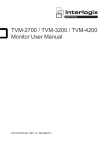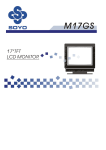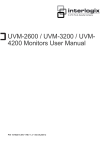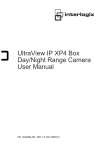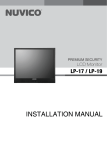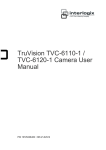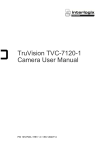Download TVM-1701 / TVM-1850 / TVM-1901 / TVM
Transcript
TVM-1701 / TVM-1850 / TVM-1901 / TVM-2150 Monitor User Manual P/N 1072775C-EN • REV 1.0 • ISS 05MAY14 Copyright European Union directives © 2014 United Technologies Corporation 2004/108/EC (EMC directive): Hereby, UTC Fire & Security Interlogix is part of UTC Building & Industrial Systems, a unit of declares that this device is in compliance with the essential requirements and other relevant provisions of Directive United Technologies Corporation. All rights reserved. Trademarks and patents 2004/108/EC. Trade names used in this document may be trademarks or registered trademarks of the manufacturers or vendors of the respective products.. Manufacturer United Technologies Corporation 2955 Red Hill Avenue, Costa Mesa, CA 92626-5923, USA 2002/96/EC (WEEE directive): Products marked with this symbol cannot be disposed of as unsorted municipal waste in Authorized EU manufacturing representative: the European Union. For proper recycling, return this product to UTC Fire & Security B.V. your local supplier upon the purchase of equivalent new Kelvinstraat 7, 6003 DH Weert, The Netherlands equipment, or dispose of it at designated collection points. For more information see: www.recyclethis.info. Certification N4131 FCC compliance Class A: This equipment has been tested and found to comply with the limits for a Class A digital device, pursuant to part 15 of the FCC Rules. These limits are designed to provide reasonable protection against harmful interference when the equipment is operated in a commercial environment. This equipment generates, uses, and can radiate radio frequency energy and, if not installed and used in accordance with the instruction manual, may cause harmful interference to radio communications. Operation of this equipment in a residential area is likely to cause harmful interference in which case the user will be required to correct the interference at his own expense. ACMA compliance Notice! This is a Class A product. In a domestic environment this product may cause radio interference in which case the user may be required to take adequate measures. Canada This Class A digital apparatus complies with Canadian ICES003. Cet appareil numérique de la classe A est conforme à la norme NMB-0330 du Canada. Contact information For contact information see: www.interlogix.com or www.utcfssecurityproducts.eu. Content Important safeguards 1. Important safeguards 1 Introduction 2 Features 2 Assembling the monitor 3 Connections 3 Front panel controls 4 Control panel (TVM-1701 model) 4 Control panel (TVM-1901/ TVM-1850/ TVM-2150 models) 4 Changing a monitor parameter 5 Hot keys 5 Adjustment procedure 5 OSD function 5 VGA menu 6 Cam menu (HDMI) 8 Self-diagnosis 10 Removing the monitor stand 10 Do not block any ventilation openings. • Always ensure that the monitor is located in a well-ventilated area to prevent the unit from overheating. • Only use accessories specified by the manufacturer or those sold with the product. • Avoid operating or placing the monitor in the following environments: extremes of temperatures, both hot and cold; high humidity; direct sunlight; excessively dusty surroundings; avoid close proximity to other equipment that generates a strong magnetic field Water and moisture: Do not use this appliance near water. To reduce the risk of fire or electric shock, do not expose this unit to rain or moisture. 3. Power cord and power cord protection: Power cords should be routed so that they not likely to be walked on or pinched. Pay particular attention to the location of cords and plugs, convenience receptacles, and the point of exit from the appliance. 4. Product care: Do not touch the screen directly with fingers. The oils from your skin may leave marks on the surface of the screen, which are difficult to be removed and may damage the screen permanently. Do not apply pressure to the screen. 5. Cleaning: Clean only with a dry cloth. 6. Servicing: Do not attempt to service this unit yourself. Opening or removing covers may expose you to dangerous voltage or other hazards. Refer all servicing to qualified service personnel. 7. Lightning: For added protection during a lighting storm or when this unit is left Troubleshooting 11 Factory preset timings 16 User Manual • 2. Attaching the monitor stand 11 Specifications 13 TVM-1701/TVM-1901 models 13 TVM-1850/TVM-2150 models 14 Installation cautions: 1 8. unattended and unused for long periods of time, unplug the unit from the wall outlet and disconnect the cable system. This will prevent damage to the unit due to lightning and power line surges. Features The monitor is designed for use in a small work area or for those who need more work space on the desk. Mains plug (2 pin/3 pin): The convenient and user-friendly onscreen display allows for easy and accurate adjustments of screen size, position and screen color. The monitor complies with the VESA Display Data Channel (DDC) specification for Plug and Play compatibility. Advanced microcircuitry makes setup and configuration fast and effortless. The monitor features Advanced Color Controls for fine-tuning to meet your own personal tastes or application requirements. Use the on-screen controls to adjust the color temperature, RGB gain value for the best possible screen color and intensity. Press the Menu button and activate the Self-Diagnosis menu to determine whether your monitor is functioning normally, not receiving a signal or is receiving a signal that is out of scanning range. Activate the higher refresh rates of the monitor to stabilize the screen and eliminate the annoying flicker that contributes to eye-strain and headaches. The monitor supports the optimal display performance with 1280x1024 @ 60 Hz (TVM-1701/TVM-1901 Model),1920x1080 @ 60 Hz (TVM-2150 Model) and 1366x768 @ 60 Hz (TVM1850 Model). The monitor can be connected to various types of video devices with supporting video input signals such as Composite video (CVBS), and Separate video. The internal stereo speakers produce a good quality audio sound. • Do not remove the grounding or earth connection from the power supply / mains plug. • Always remember to unplug the monitor from the power supply under the following circumstances if the monitor will not be used for a long period of time, if the power supply cable or plug/connector is damaged or if the monitor housing is damaged or broken. CAUTION: Do not attempt to dismantle this product. Any attempt to dismantle or remove the covers from this product will invalidate the warranty and may also result in serious injury. Introduction This manual explains how to correctly install, operate and get the best performance from your monitor. Please read this user manual carefully before installing your monitor then keep it near your monitor for quick reference. First, please check that the contents of the box correspond with the following checklist: • LED monitor • Power cord • VGA cable • AC adaptor • User manual If any item is missing or damaged, please contact your dealer. Please keep the box and packing materials so that you may properly store or transport your monitor. 2 User Manual Assembling the monitor TVM-1701/TVM1901 models The monitors are designed for use on a desktop. The arm of the monitor stand is shipped preinstalled on the monitor. To assemble the monitor: 1. Put a smooth pad or cloth on a level surface. Place the monitor on it facing downwards. 2. Insert the arm of the monitor stand of the monitor into the pedestal foot provided. See figures below. TVM-1850/TVM-2150 models TVM-1701/TVM-1 901 models Connections TVM-1850/TVM-2150 models 1. DC 12V Input 2. VIDEO OUT Composite signal output To disassemble the monitor: 1. Put a smooth pad or cloth on a level surface. Place the monitor on it facing downwards. 2. Using a screwdriver or a similar object with a sharp end, carefully detach the supporting arm from the foot by pressing the groove on the back of the supporting arm. (Note that the fixation point can be broken if too much force is applied). See figures below. 3. VIDEO IN Composite signal input. 4. AUDIO L Audio signal input left. 5. AUDIO R Audio signal input right. 6. PC Stereo Input 7. Head Phone Out 8. USB Service port 9. HDMI HDMI signal input. 10. VGA RGB signal input. User Manual 3 Front panel controls 6. AUTO (*) Primary Function: Automatically adjusts the display to the most optimal setting possible. (VGA mode only) Control panel (TVM-1701 model) Secondary Function: Selects the sub menu Control panel (TVM-1901/ TVM1850/ TVM-2150 models) 1. POWER indicator Shows both normal operation and power management status with power LED 2. POWER Switches the monitor on and off. 3. MENU Turns the OSD window on. Turns the OSD window off and moves from sub menu to top menu in the OSD window. *Push the menu button for 5seconds when you want to unlock the keypad lock. 4. ▼ Down Arrow (*) Primary Function: Used to decrease the volume. Secondary Function: Moves cursor to the down in the OSD window and decreases the value of any selected menu. 5. 1. Shows both normal operation and power management status with power LED. 2. POWER Switches the monitor on and off. 3. ▶ Right Arrow (*) Primary Function: Used to increase the volume. ▲ Up Arrow (*) Secondary Function: Moves the cursor to the right in the OSD window and increases the value of any selected menu. Primary Function: Used to select from different input sources. Secondary Function: Moves cursor to the up in the OSD (On-Screen Display) window and increases the value of any selected menu. POWER indicator 4. ◀ Left Arrow (*) Primary Function: Used to decrease the volume. Secondary Function: Decreases the value of any selected menu. 4 User Manual 5. ▲ Up Arrow (*) Primary Function: Automatically adjusts the display to the most optimal setting possible. (VGA mode only) Secondary Function: Allows for vertical scrolling in the OSD menu. 6. Selects signal in order. VGA HDMI - CAM ▲ (UP/AUTO) When there is no OSD, if you press this ▲ (UP/AUTO) button, you can use the best display performance fit for a current mode ◀ ▶ (VOLUME) When there is no OSD, you can adjust the volume directly SOURCE (*) Used to select different input sources. Press the UP or DOWN arrow to scroll through the available sources, and press SOURCE arrow to confirm selection. 8. SOURCE ▼ Down Arrow Allows for vertical scrolling in the OSD menu. 7. Hot keys Adjustment procedure MENU Turns the OSD window on. Turns the OSD window off and moves from sub menu to top menu in the OSD window. Changing a monitor parameter 1. Press the MENU button on the front panel to obtain the OSD menu screen. 2. Use UP-DOWN buttons to select the menu. 3. Use AUTO or SOURCE button to select the submenus. 4. Use Up-Down buttons to select a submenu function. 5. Press AUTO or SOURCE button, then using left-right buttons you can make adjustments as necessary. 6. To exit, press MENU. User Manual OSD function Configure the monitor using the on-screen display (OSD) menus and submenus. Changes are immediately saved and implemented. 5 VGA menu 3. Color Tone Choose a different preset color temperature or set your own customized color parameters. (Normal/ Warm/ Cool/ User). Picture 4. Advanced Setting 4-1 Noise Reduction. Not used. 4-2 Back Light Adjust the back light to be brighter or darker. 4-3 DCR Not used. (Advanced Settings) 4-4 DCC Not used. 5. VGA Setting 5-1 Auto adjust Automatically choose the correct horizontal position and vertical position and size of the screen image. 5-2 H-Position (VGA setting) Adjust the position of the display horizontally (left or right). 5-3 V-Position Adjust the position of the display vertically (up or down). 5-4 Phase Remove any horizontal noise and clear or sharpen the image of the characters. 5-5 Clock 1. Brightness Adjust the width (horizontal size) of the screen image. Adjust the brightness of the image. 2. Contrast Adjust the contrast of the image, the difference between light and dark areas on the screen. 6 User Manual Sound 1. Sound Mode Choose a different preset sound mode or your own customized sound. (Standard/ Speech/ Music/ User) 2. Balance Adjust the sound balance of the left and right speakers. 3. Bass When you select User mode, adjust the bass sound. 4. Equalizer Provides an enhanced listening experience. 6. 1. Auto Volume Automatically remains at the same volume level if you change the program. System Menu Language Select language for the OSD. 2. Screen Format Select the aspect ratio (16:9/4:3). 3. OSD Time out Adjust the display of the OSD menu (10 to 60 seconds). 4. OSD Transparency Adjust the OSD transparency. Treble When you select the user mode, adjust the treble sound. 5. (Time setting) (off/Low/Middle/High) 5. Power on Status Not used. 6. Blue Screen Select the background color. 7. Time Setting 7-1 Time Not used. 7-2 Sleep Timer Set the sleep timer. 7-3 Auto Sleep The monitor turns off when it does not receive any signal from the remote control or any button within the time set up (Off/ 1 Hour/ 2 Hours/ 5 Hours). (A screen warning is displayed before the configured automatic shutdown time). User Manual 7 8. Memory Recall (Advanced Setting) Reset the screen to the factory preset display settings. Lock 1. Picture Mode Select the picture mode (Standard/Movie/Dynamic/User/Eco). 1. Keypad Lock 2. Adjust the brightness of the image. Turn the keypad lock on or off. 2. Remote Control Lock (optional) 3. Contrast Adjust the contrast of the image, the difference between light and dark areas on the screen. Turn the remote control lock on or off. Cam menu (HDMI) Brightness 4. Color Mode Adjust the color of the image. Picture 5. Sharpness Adjust the image quality of the display. 6. Tint (cam mode only) Adjust the tint of the image. 7. Color Tone Choose a different preset color temperature or set your own customized color parameters (Normal/ Warm/ Cool/ User). 8. Advanced Setting 8-1 Noise Reduction Reduce the noise in the picture due to poor reception or poor picture quality. (Off/ Low/ Middle/ High). 8-2 Back Light Adjust the back light to be brighter or darker. 8 User Manual 8-3 DCR System The dynamic contrast ratio (DCR) automatically adjusts the screen brightness. Turn DCR on or off. 8-4 DCC The dynamic contrast control (DCC) automatically adjusts the screen contrast. Turn DCC on or off. Sound (Time Setting) 1. 1. Sound Mode Choose a different preset sound mode or your own customized sound. (Standard/ Movie/ Music/ User) 2. 3. Treble When you select the user mode, adjust the treble sound. 5. Equalizer Provides an enhanced listening experience. 6. Auto Volume Automatically remains at the same volume level if you change the program. User Manual Screen Format Select the aspect ratio (16:9/4:3/ZOOM1/ZOOM2/FULL(HDMI mode only)). 3. OSD Time out Adjust the display time of the OSD menu (10 to 60 seconds). Bass When you select User mode, adjust the bass sound. 4. Select the OSD language. 2. Balance Adjust the sound balance of the left and right speakers. Menu Language 4. OSD Transparency Adjust the OSD transparency. 5. Power on Status Not used. 6. Blue Screen Select the background color. 7. Video Standard (cam mode only) Select the picture mode 9 8. Time Setting 8-1 Time Not used. 8-2 Sleep Timer Set sleep timer. 8-3 Auto Sleep The No Signal screen is displayed when the D-Sub signal connector is connected but the status of the monitor is on DPMS mode. The monitor turns off when it does not receive any signal from the remote control or any button within the time set up (Off/ 1 Hour/ 2 Hours/ 5 Hours). 9. (A screen warning is displayed before the configured automatic shutdown time). The Out of Range screen is displayed when the applied frequency is under or over normal range. Memory Recall Normal range (Non-interlaced mode only): Reset the screen to the factory preset display settings. H: 30 to 80 kHz V: 56 to 77 Hz Lock Press any key to cancel. Monitor is turned off when it does not receive any signal from the remote control or any button within the time that set up. 1. Keypad Lock Turn the keypad lock on or off. 2. Remote Control Lock (optional) Turn the remote control lock on or off. Self-diagnosis If there is no image, the Self-Diagnosis screen will be displayed. The self-diagnosis function checks if the status of the monitor screen is No Signal, Out of Range, or None Supported. 10 Removing the monitor stand 1. Turn off the monitor and unplug the power cable. 2. Place a cushion or a soft cloth on the floor and put the monitor on it with the front of the monitor facing the floor. 3. Detach the rear cover of the monitor stand with a screwdriver. 4. Remove the four screws connecting the stand and monitor body. See figures below. User Manual TVM-1701/TVM-1901 models The monitor’s installation surface is compatible with other types of VESA standard stands. Hole spacing: 100 x 100 mm Screw length: 8 to12 mm Troubleshooting TVM-1850/TVM-2150 model Symptom Check Picture is jittery Adjust Clock to set the screen position and adjust the Clock value carefully until there is no noise displayed. No picture Check if the power switch and computer power switch are in the On position. Attaching the monitor stand Check if the signal cable is correctly connected to the video card. Tighten the screws at the locations indicated by the arrows shown in the figures below. Check if the pins of D subconnector are not bent. TVM-1701/TVM-1901 models Check if the computer is in the power- saving mode. POWER LED is not lit Check if the power switch is in the On position. Check if the power cord is correctly connected. TVM-1850/TVM-2150 models User Manual Image is unstable Check if the signal cable is suitable to the video card. Image is not centered, too small, or too large Adjust Clock or H&V Center to get the proper image. Picture bounces or a wave pattern is present in the picture Keep the devices that may cause electrical interference away from the monitor. See the FCC information at the front cover of the 11 Symptom Check manual. Picture is blurred Adjust Contrast and Brightness. No sound Check the audio cables are correctly connected to the computer. Adjust the volume after checking the sound is muted. Check the audio system in the computer. Low sound Adjust the volume on the OSD menu. Adjust the volume of the sound card in the computer. VIDEO screen cannot be seen Check if PICTURE mode has been set. Check if the video terminal is properly connected. No video Check if the video cable is correctly connected to the computer and set to Functions on the OSD picture menu. Poor color in the video Adjust the Color or Tint values on the OSD Picture menu. Grainy picture in the video Adjust the Sharpness on the OSD Picture menu. 12 User Manual Specifications TVM-1701/TVM-1901 models Items Model TVM-1701 Model TVM-1901 Screen size 17 in. (43.cm) 19 in. (48.3 cm) Pixel pitch 0.264 x 0.264 mm 0.294 x 0.294 mm View angle (H/V) 170°/160° 170°/160° Contrast ratio 1000:1 (typ) 1000:1 (typ) Response time 5 ms 5 ms Brightness 250 cd/m² (typ) 250 cd/m² (typ) Recommended resolution 1280 x 1024 @ 60 Hz 1280 x 1024 @ 60 Hz Speaker power 2Wx2 2Wx2 Speakers Built-in Built-in Sound features Stereo R/L Stereo R/L VGA in (15 Pin DSub) 1 1 HDMI in 1 1 Audio (L/R) 1/1 1/1 BNC (in/out) 1/1 1/1 PC Audio in Yes Yes Head phone out Yes Yes Service (USB) Yes Yes Consumption < 25 W < 25 W Source 12 VDC, 3.33 A 12 VDC, 3.33 A Special feature Filter type 3D comb filter, deinterlacing 3D comb filter, deinterlacing Dimensions W x H x D (without stand) 384 x 310 x 63 mm 15.11 x 12.20 x 2.48 in 422 x 338 x 66 mm 16.61 x 13.30 x 2.59 in. W x H x D (with stand) 384 x 358 x 196 mm 15.11 x 14.09 x 7.71 in 422 x 388 x 196mm 16.81 x 15.27 x 7.71 in. W x H x D (box) 411 x 377 x 130 mm 470 x 389 x 132 mm Panel Audio Interface Power User Manual 13 Items Weight VESA mount Model TVM-1701 Model TVM-1901 16.18 x 14.84 x 7.67 in 18.5 x 15.3 x 5.2 in. Net (without stand) 3.1kg (6.8lb.) 4.0 kg (8.82 lb.) Net (with stand) 3.8kg (8.4lb.) 4.8 kg (10.58 lb.) Gross (box) 4.7kg (10.4lb.) 5.3 kg (11.7 lb.) VESA standard 100 x 100 mm (3.94 x 3.94 in.) 100 x 100 mm (3.94 x 3.94 in.) Spacing screw size M4 screw M4 screw Length 8.00 mm 8.00 mm Specifications Hole patterns Operating temperature 0 to 40 °C (32 to 104 °F) The specifications can change without any notice. The panel may have some defective pixels (ex. slightly light or dark) due to a characteristic of the panel. But there is no defect in your panel product itself. TVM-1850/TVM-2150 models Items Panel Audio Interface 14 Model TVM-1850 Model TVM-2150 Screen size 18.5 in. (46.9 cm) 21.5 in. (54.6 cm) Pixel pitch 0.3 (H) x 0.3(V) 0.248 (H) x 0.248(V) View angle (H/V) 170°/160° 170°/160° Contrast ratio 1000:1 (typ) 1000:1 (typ) Response time 3.5 ms 5 ms Brightness 250 cd/m² (typ) 250 cd/m² (typ) Recommended resolution 1366 x 768@60Hz 1920 x 1080@60Hz Speaker power 2Wx2 2Wx2 Speakers Built-in Built-in Sound features Stereo R/L Stereo R/L VGA in (15 Pin DSub) 1 1 HDMI in 1 1 Audio (L/R) 1/1 1/1 BNC (in/out) 1/1 1/1 User Manual Items Model TVM-1850 Model TVM-2150 PC Audio in Yes Yes Head phone out Yes Yes Service (USB) Yes Yes Consumption < 30 W < 30 W Source 12 VDC, 3.33 A 12 VDC, 3.33 A Special feature Filter type 3D comb filter, deinterlacing 3D comb filter, deinterlacing Dimensions W x H x D (without stand) 472 x 274 x 61 mm 18.58 x 10.78 x 2.40in. 542 x 318 x 62 mm 21.33 x 12.51 x 2.44 in. W x H x D (with stand) 472 x 317 x 207 mm 18.58 x 12.48 x 8.14in. 542 x 368 x 207 mm 21.337 x 14.48 x 8.14 in. W x H x D (box) 530 x 387 x 173 mm 20.87 x 15.24 x 6.8 in. 574 x 412 x 158 mm 22.6 x 16.2 x 6.2 in. Net (without stand) 2.5 kg (5.5 lb.) 3.3 kg (7.2 lb.) Net (with stand) 3.2 kg (7.0 lb.) 4.0 kg (8.8 lb.) Gross (box) 5.0 kg (11 lb.) 6.3 kg (13.9 lb.) VESA mount VESA standard 100 x 100 mm (3.94 x 3.94 in.) 100 x 100 mm (3.94 x 3.94 in.) Specifications Spacing screw size M4 screw M4 screw Hole patterns Length 8.00 mm 8.00 mm Operating temperature 0 to 40 °C (32 to 104 °F) Power Weight The specifications can change without notice. The panel may have some defective pixels (ex. slightly light or dark) due to a characteristic of the panel. But there is no defect in your panel product itself. User Manual 15 Factory preset timings Pixel Format Horizontal Freq. (KHz) Vertical Freq. (Hz) Remark 720 x 400 31.469 70.087 all models 640 x 480 31.469 59.940 all models 640 x 480 37.861 72.809 all models 640 x 480 37.500 75.000 all models 800 x 600 37.870 60.317 all models 800 x 600 48.077 72.188 all models 800 x 600 46.875 75.000 all models 1024 x 768 48.360 60.000 all models 1024 x 768 56.476 70.069 all models 1024 x 768 60.020 75.030 all models 1152 x 864 59.986 59.985 TVM-1701/ TVM-1901/ TVM-2150 1152 x 864 67.500 75.000 TVM-1701/ TVM-1901/ TVM-2150 1280 x 1024 63.981 60.020 TVM-1701/ TVM-1901/ TVM-2150 1280 x 1024 79.974 75.024 TVM-1701/ TVM-1901/ TVM-2150 1360 x 768 47.712 59.790 TVM-1850 1440 x 900 55.935 59.887 TVM-2150 1680 x 1050 65.290 59.954 TVM-2150 1920 x 1080 67.500 60.000 TVM-2150 The LED monitor has only non-interlaced modes without flicker. 16 User Manual





























